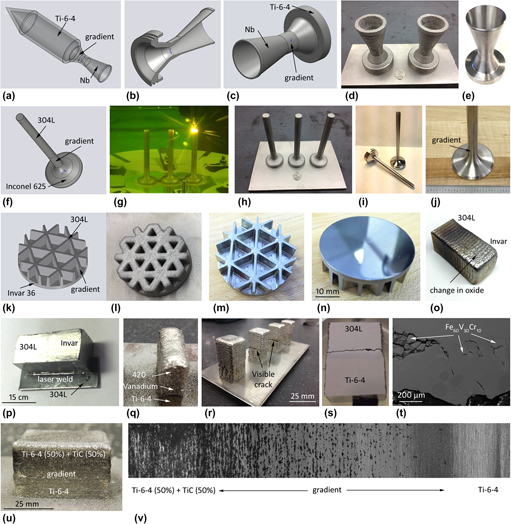Crossref Citations
This article has been cited by the following publications. This list is generated based on data provided by
Crossref.
Wei, H. L.
Mazumder, J.
and
DebRoy, T.
2015.
Evolution of solidification texture during additive manufacturing.
Scientific Reports,
Vol. 5,
Issue. 1,
Zocca, Andrea
Colombo, Paolo
Gomes, Cynthia M.
Günster, Jens
and
Green, D. J.
2015.
Additive Manufacturing of Ceramics: Issues, Potentialities, and Opportunities.
Journal of the American Ceramic Society,
Vol. 98,
Issue. 7,
p.
1983.
Fang, Xuewei
Du, Jun
Wei, Zhengying
Wang, Xin
He, Pengfei
Bai, Hao
Wang, Bowen
Chen, Jian
Geng, Ruwei
and
Lu, Bingheng
2016.
Study on Metal Deposit in the Fused-coating Based Additive Manufacturing.
Procedia CIRP,
Vol. 55,
Issue. ,
p.
115.
Borkar, T.
Gwalani, B.
Choudhuri, D.
Mikler, C.V.
Yannetta, C.J.
Chen, X.
Ramanujan, R.V.
Styles, M.J.
Gibson, M.A.
and
Banerjee, R.
2016.
A combinatorial assessment of AlxCrCuFeNi2 (0 < x < 1.5) complex concentrated alloys: Microstructure, microhardness, and magnetic properties.
Acta Materialia,
Vol. 116,
Issue. ,
p.
63.
Shapiro, A. A.
Borgonia, J. P.
Chen, Q. N.
Dillon, R. P.
McEnerney, B.
Polit-Casillas, R.
and
Soloway, L.
2016.
Additive Manufacturing for Aerospace Flight Applications.
Journal of Spacecraft and Rockets,
Vol. 53,
Issue. 5,
p.
952.
Mueller, Robert P.
Howe, Scott
Kochmann, Dennis
Ali, Hisham
Andersen, Christian
Burgoyne, Hayden
Chambers, Wesley
Clinton, Raymond
De Kestellier, Xavier
Ebelt, Keye
Gerner, Shai
Hofmann, Douglas
Hogstrom, Kristina
Ilves, Erika
Jerves, Alex
Keenan, Ryan
Keravala, Jim
Khoshnevis, Behrokh
Lim, Sungwoo
Metzger, Philip
Meza, Lucas
Nakamura, Takashi
Nelson, Andrew
Partridge, Harry
Pettit, Donald
Pyle, Rod
Reiners, Eric
Shapiro, Andrew
Singer, Russell
Tan, Wei-Lin
Vazquez, Noel
Wilcox, Brian
and
Zelhofer, Alex
2016.
Automated Additive Construction (AAC) for Earth and Space Using In Situ Resources.
p.
354.
Carroll, Beth E.
Otis, Richard A.
Borgonia, John Paul
Suh, Jong-ook
Dillon, R. Peter
Shapiro, Andrew A.
Hofmann, Douglas C.
Liu, Zi-Kui
and
Beese, Allison M.
2016.
Functionally graded material of 304L stainless steel and inconel 625 fabricated by directed energy deposition: Characterization and thermodynamic modeling.
Acta Materialia,
Vol. 108,
Issue. ,
p.
46.
Khan, Sohaib Z
Masood, S.H.
and
Cottam, Ryan
2017.
Mechanical properties of a novel plymetal manufactured by laser-assisted direct metal deposition.
The International Journal of Advanced Manufacturing Technology,
Vol. 91,
Issue. 5-8,
p.
1839.
Bobbio, Lourdes D.
Otis, Richard A.
Borgonia, John Paul
Dillon, R. Peter
Shapiro, Andrew A.
Liu, Zi-Kui
and
Beese, Allison M.
2017.
Additive manufacturing of a functionally graded material from Ti-6Al-4V to Invar: Experimental characterization and thermodynamic calculations.
Acta Materialia,
Vol. 127,
Issue. ,
p.
133.
Tammas-Williams, S.
and
Todd, I.
2017.
Design for additive manufacturing with site-specific properties in metals and alloys.
Scripta Materialia,
Vol. 135,
Issue. ,
p.
105.
Knoll, Helene
Ocylok, Sörn
Weisheit, Andreas
Springer, Hauke
Jägle, Eric
and
Raabe, Dierk
2017.
Combinatorial Alloy Design by Laser Additive Manufacturing.
steel research international,
Vol. 88,
Issue. 8,
p.
1600416.
Bourell, David
Kruth, Jean Pierre
Leu, Ming
Levy, Gideon
Rosen, David
Beese, Allison M.
and
Clare, Adam
2017.
Materials for additive manufacturing.
CIRP Annals,
Vol. 66,
Issue. 2,
p.
659.
2017.
Mikler, C. V.
Chaudhary, V.
Borkar, T.
Soni, V.
Jaeger, D.
Chen, X.
Contieri, R.
Ramanujan, R. V.
and
Banerjee, R.
2017.
Laser Additive Manufacturing of Magnetic Materials.
JOM,
Vol. 69,
Issue. 3,
p.
532.
Ren, Luquan
Zhou, Xueli
Song, Zhengyi
Zhao, Che
Liu, Qingping
Xue, Jingze
and
Li, Xiujuan
2017.
Process Parameter Optimization of Extrusion-Based 3D Metal Printing Utilizing PW–LDPE–SA Binder System.
Materials,
Vol. 10,
Issue. 3,
p.
305.
Liu, Zengqian
Meyers, Marc A.
Zhang, Zhefeng
and
Ritchie, Robert O.
2017.
Functional gradients and heterogeneities in biological materials: Design principles, functions, and bioinspired applications.
Progress in Materials Science,
Vol. 88,
Issue. ,
p.
467.
Du, Jun
Wang, Xin
Bai, Hao
Zhao, Guangxi
and
Zhang, Yubin
2017.
Numerical analysis of fused-coating metal additive manufacturing.
International Journal of Thermal Sciences,
Vol. 114,
Issue. ,
p.
342.
Conteri, R.
Borkar, T.
Nag, S.
Jaeger, D.
Chen, X.
Ramanujan, R.V.
and
Banerjee, R.
2017.
Laser additive processing of Fe-Si-B-Cu-Nb magnetic alloys.
Journal of Manufacturing Processes,
Vol. 29,
Issue. ,
p.
175.
Pawlowski, Alexander E.
Cordero, Zachary C.
French, Matthew R.
Muth, Thomas R.
Keith Carver, J.
Dinwiddie, Ralph B.
Elliott, Amelia M.
Shyam, Amit
and
Splitter, Derek A.
2017.
Damage-tolerant metallic composites via melt infiltration of additively manufactured preforms.
Materials & Design,
Vol. 127,
Issue. ,
p.
346.
Marker, Cassie
Ross, Austin
and
Liu, Zi-Kui
2018.
Computational Materials System Design.
p.
27.



